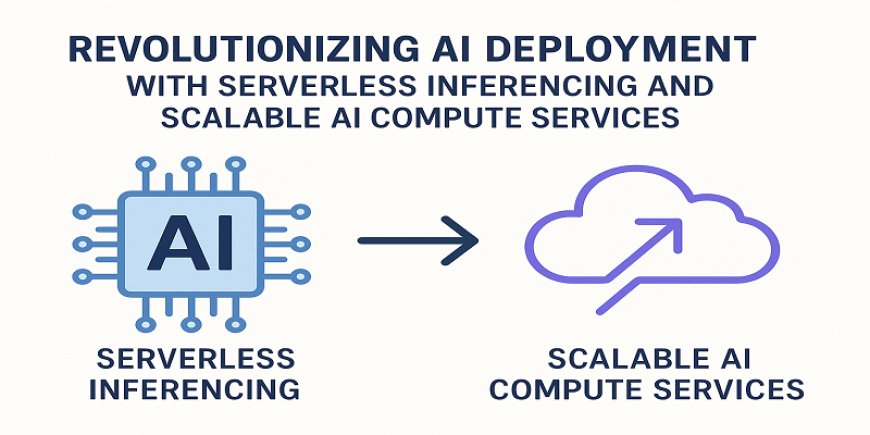Revolutionizing AI Deployment with Serverless Inferencing and Scalable AI Compute Services
In this blog, we’ll explore what serverless inferencing is, how it works, and why it’s becoming a game-changer in the AI ecosystem.

In the fast-paced world of artificial intelligence, the way AI models are trained and deployed is constantly evolving. One of the most significant advancements in this area is serverless inferencinga model execution approach that enables organizations to run AI workloads without the need to manage infrastructure. Combined with scalable AI compute services, this technology is streamlining the deployment of machine learning models, reducing costs, and accelerating time-to-value for businesses across industries.
In this blog, well explore what serverless inferencing is, how it works, and why its becoming a game-changer in the AI ecosystem.
What is Serverless Inferencing?
Serverless inferencing refers to the execution of AI models on demand, without requiring the user to provision or manage the underlying compute infrastructure. Instead of running inference tasks on a dedicated server, the application invokes a model only when needed, and the cloud provider (or compute platform) dynamically allocates the required resources in the background.
This approach brings the benefits of serverless computing to the world of AI by abstracting away infrastructure complexities and allowing developers to focus purely on model performance and application logic.
Key characteristics of serverless inferencing include:
-
Automatic Scaling: Compute resources scale automatically based on demand.
-
Event-driven Execution: Inference tasks are triggered by specific events or API calls.
-
Pay-per-use Pricing: Users are charged based on actual compute usage rather than idle time.
-
Zero Infrastructure Management: No need to worry about server setup, maintenance, or scaling logic.
How Serverless Inferencing Works
The serverless inferencing pipeline typically starts when an AI model is trained and stored in a cloud-based repository or model registry. Once the model is ready for deployment, developers configure it as a serverless function or endpoint.
When an inference request is madesay, a user uploads an image for classification or a chatbot receives a questionthe serverless system quickly spins up the necessary resources, runs the model, returns the result, and shuts down the compute environment.
Behind the scenes, AI compute services are responsible for provisioning GPU or CPU resources, allocating memory, and managing runtime containers. This orchestration is invisible to the end user, creating a seamless experience with minimal latency and maximum efficiency.
Why Serverless Inferencing Matters
-
Cost-Efficiency:Traditional AI deployment often involves maintaining costly virtual machines or containers that run 24/7. Serverless inferencing eliminates idle resource costs by charging only when inferences are actually made. This is especially useful for applications with unpredictable or spiky workloads.
-
Simplified Operations:Serverless architecture removes the burden of maintaining compute infrastructure, load balancers, and auto-scaling groups. This allows developers and data scientists to concentrate on building better models rather than managing hardware.
-
Faster Deployment Cycles:With serverless inferencing, models can be deployed quickly as stateless functions or microservices. This accelerates the ML lifecycle, enabling faster experimentation and iterationcrucial for time-sensitive AI applications like fraud detection or real-time personalization.
-
Scalability on Demand:Whether handling a single request or a million, serverless platforms can scale compute power automatically. This elasticity ensures consistent performance even during traffic spikes, making it ideal for consumer-facing AI apps.
-
Greater Accessibility:Serverless inferencing democratizes AI by making it accessible to startups, researchers, and small teams who may not have the expertise or resources to manage infrastructure. It lowers the entry barrier and fosters innovation across industries.
The Role of AI Compute Services
Serverless inferencing would not be possible without the backbone of modern AI compute services. These services provide the infrastructure layer that delivers raw computational poweroften in the form of GPU-accelerated instances or specialized AI chipsneeded to perform high-speed inference.
Key features offered by AI compute services include:
-
Flexible compute instance types (CPU, GPU, TPU)
-
Containerized environments for deploying models
-
Support for popular ML frameworks like TensorFlow, PyTorch, and ONNX
-
Integration with serverless platforms and APIs
-
Monitoring and logging tools for tracking model performance
When paired with serverless execution, these AI compute services allow developers to fine-tune performance, optimize latency, and manage large-scale inference workloads without getting bogged down by infrastructure limitations.
Common Use Cases for Serverless Inferencing
The versatility of serverless inferencing makes it a natural fit for a wide range of applications, including:
-
Real-time Recommendation Engines: E-commerce platforms can suggest products on the fly based on user behavior.
-
Intelligent Virtual Assistants: Chatbots can process natural language queries without delay.
-
Image and Video Recognition: Healthcare and security applications can analyze visual data without storing it long-term.
-
Fraud Detection Systems: Financial institutions can score transactions in milliseconds to detect anomalies.
-
Smart IoT Devices: Edge-based devices can leverage cloud inferencing for low-latency decisions.
Final Thoughts
Serverless inferencing is more than just a buzzwordits a paradigm shift in how AI models are deployed and scaled in production. By removing the complexity of infrastructure management and coupling it with robust AI compute services, businesses can unlock faster, more cost-effective, and highly scalable AI solutions.
As the demand for intelligent applications continues to rise, adopting serverless inferencing will not only improve operational efficiency but also future-proof your AI strategy in an increasingly digital world.
Whether youre a data scientist building models or a developer integrating AI into your application, serverless inferencing offers a powerful, modern approach to deploy machine learning with ease and impact.











































